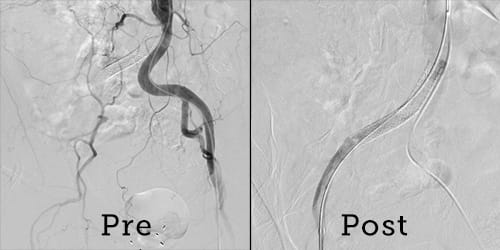UH Team Saves Leg and Life of Kentucky Man Facing Amputation
September 24, 2023

Just months after cramping in his leg led to a diagnosis of peripheral artery disease, Daniel Boynton was delivered devastating news by his doctors in Lexington, Kentucky: his leg must be amputated.
Three different doctors told Daniel, then 73, the vessels in his right leg were completely blocked. Attempts to stent the vessel in his leg were unsuccessful in Lexington. His toes started turning black.
We may have to take your leg, said the doctors in Kentucky. No, Daniel declared. More than half of U.S. patients who lose a leg died within one year, according to the National Institutes of Health.
Then Daniel met a physician who studied under interventional cardiologist Mehdi Shishehbor, DO, president of University Hospitals Harrington Heart & Vascular Institute and head of the Limb Salvage Advisory Council. This multidisciplinary team of vascular surgeons, endovascular interventionalists, vascular medicine specialists, podiatrists and wound care experts – many trained by Dr. Shishehbor himself – work together to save a patient’s leg in more than 90 percent of cases.
“Losing a leg has significant ramifications,” said Dr. Shishehbor, who is nationally published for his success with limb salvage. “There is almost always an option. Amputation should be the last choice. We need our patients to be asking for a second and third opinion before they go for an amputation.”
Patients have traveled from more than 17 states, including Florida, California, Georgia, North Carolina, Virginia and Pennsylvania, to be treated by Dr. Shishehbor’s team.
A Miracle

“I had three doctors say they were going to take my leg, and then I had a couple nurses tell me they’ve come a long way with prosthetics,” Daniel recalled. “I still said no. Then I came to Cleveland. God brought the right doctor in.”
After several months trying to get an appointment with a neurologist, then learning he needed a vascular specialist, time was critical for Daniel. He traveled six hours to Cleveland, met with Dr. Shishehbor, and was quickly scheduled for his minimally invasive endovascular revascularization.
As with a cardiac catheterization, Dr. Shishehbor used wires, medicated balloons and stents to clear and clean his patient’s vessels and stent them to prevent them from closing again. He entered Daniel’s leg from the foot and the groin, to suck out clots and clean up the arteries. Some blockages can be a foot or more in length, Dr. Shishehbor said.
“Every artery in his right leg was blocked 100 percent from his belly button to his ankle,” Dr. Shishehbor said. “He ended up losing nothing, and now he’s walking and doing his squats. He’s a miracle man. It’s unbelievable.”
Activation, Not Amputation
Dr. Shishehbor has a very clear directive: before an amputation is ever considered, except in an emergency trauma situation, the Limb Salvage Advisory Council must be activated.
Through this team approach, the council has saved more than 150 patients’ legs in the past year.
Procedures only require conscious sedation, as in a colonoscopy, rather than general anesthesia. Patients usually go home the next day after the minimally invasive procedures and return for wound care over the resuming weeks.
Almost every site in the UH system – from UH Elyria to UH Samaritan to UH Geauga medical centers – can take care of these patients now.
Daniel still has some residual neuropathy, or nerve damage, but is otherwise happy and grateful.
“It was a long and traumatic journey, but we made it through,” said Daniel, who sent a bottle of Kentucky bourbon to his favorite doctor in a heartfelt gesture of thanks. “I’m a happy camper. I’ve got my leg, I’ve got all my toes, and I can walk – thanks to Dr. Shishehbor and his crew. And God.”


